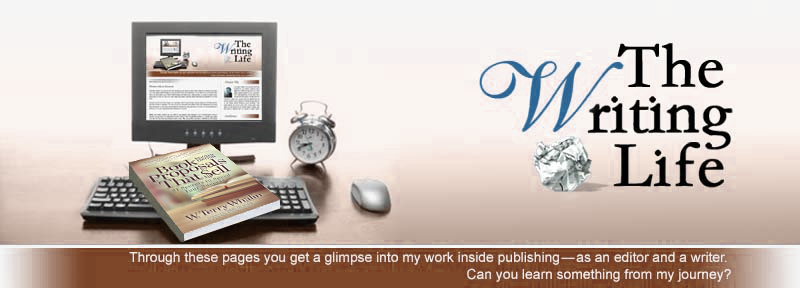Unspoken Proposal Rules
Many aspects of life have unspoken rules. When you bump into them, you begin to learn, then use these rules to your advantage. The rules are different in each culture. For example, in the U.S., women in particular like to dress differently. If there is a formal event, no woman likes to arrive in exactly the same dress as someone else in the room. Years ago when I lived in Guatemala, the culture was completely the reverse. Each town in the country maintains a separate outfit of dress. In particular, the women have maintained their cultural distinctness. Yet every woman in the town dresses exactly alike. It gives the advantage when they are outside of their town context, you can instantly know their home town from their appearance. For me, this cultural distinction was fascinating because it was completely opposite of my expectations.
 These unspoken rules happen in publishing as well. One of my readers for Book Proposals That Sell wrote and raised some questions. I began to think about these rules which I had learned naturally yet I haven’t seen them explicitly in writing. Within a publishing house, the different acquisitions editors are colleagues, yet each editor locates new projects, then prepares the paperwork to bring those projects into the editorial process. Often this editorial process involves a meeting where the editors meet together and present their different projects, discussing how they can be improved before they are taken to the publication board. If the editorial group agrees the proposal is something that should be considered, then it is taken to the publication board (which includes representatives of sales and marketing and the leadership of the publishing house). While there isn’t an overt rivalry between the acquisitions editors in the same house, there is a sense that each person is bringing unique book proposals into the publication process. The writer is eager to have as many people as possible consider their book proposal. Here’s the unspoken rule: you don’t want to have two acquisitions editors inside the same publisher enthused about the exact same book proposal.
These unspoken rules happen in publishing as well. One of my readers for Book Proposals That Sell wrote and raised some questions. I began to think about these rules which I had learned naturally yet I haven’t seen them explicitly in writing. Within a publishing house, the different acquisitions editors are colleagues, yet each editor locates new projects, then prepares the paperwork to bring those projects into the editorial process. Often this editorial process involves a meeting where the editors meet together and present their different projects, discussing how they can be improved before they are taken to the publication board. If the editorial group agrees the proposal is something that should be considered, then it is taken to the publication board (which includes representatives of sales and marketing and the leadership of the publishing house). While there isn’t an overt rivalry between the acquisitions editors in the same house, there is a sense that each person is bringing unique book proposals into the publication process. The writer is eager to have as many people as possible consider their book proposal. Here’s the unspoken rule: you don’t want to have two acquisitions editors inside the same publisher enthused about the exact same book proposal.
Just imagine in your enthusiasm for the book proposal, you give it to two editors inside the same publishing house. Because they present these projects at an editorial meeting, the duplicity will be discovered—to the detriment of the writer. It’s simply giving both editors cause to reject your project. More importantly than the single rejection, it will raise questions about your future submissions—as to whether you have blanketed the publisher with your proposal submissions.
Let’s carry this situation a bit further—and reveal a more subtle rule. Often a single publisher will contain many different imprints. Depending on the publisher, some of those imprints are not even located in the same building or even the same city. It is not appropriate to submit your book proposal to different imprints of the same larger publisher. Let’s imagine you have an excellent book proposal which could easily go in one company or the other company so you decide to send it to both imprints. An acquisitions editor in each imprint gets excited about your contents and champions your cause to get it contracted. Even if it progresses through each internal system, eventually the duplicity will be discovered—and it will not go well for the writer in this process. Your “excellent proposal” risks rejection from both publishers and the questions will be raised with your future submissions.
As a writer, I completely understand your eagerness to get your proposal to as many places as possible—and submit them at the same time because the process takes a long time. Yet there are some cautions to observe in this process.
Here’s a final one that few writers seem to consider—and it happens primarily with fiction. It’s almost universal that first-time novelists have to complete their entire manuscript—before they can receive serious consideration from a publishing house. Admittedly it’s a great deal of work to craft an excellent story and sustain that excellence over 80,000 to 100,000 words. You go to a large writer’s conference with your manuscript or your pitch or your proposal. During the conference, you meet with a number of editors and literary agents. The editor looks at your work and asks you to send it to them. At the same time, the agent looks at your work and sees merit and requests a copy of the manuscript. You return from the conference and follow-up with all of the various requests. What if for a variety of reasons (there are many reasons), all of the publishers look at your material and decide to reject it. But the literary agent carefully reads your manuscript and decides they want to represent it for you. You love receiving this news from the literary agent. If your agent is worth their salt, they are going to ask you, “Who has seen this manuscript?” You provide the list of these publishers who have rejected your work. Essentially you have tied the agent’s hands through your enthusiastic efforts to find a publisher. You will have to transform the manuscript into a completely new work—new title and new emphasis for the literary agent to gain a repeat hearing with those publishers who have rejected your work. Why? Editors keep logs of the submissions (I do) and if I see something which seems a bit familiar, I can pull up this file and search through it—for your name, your title and whatever details about the story that I wrote into my log. Unknowingly in your enthusiasm to market your manuscript, you’ve actually limited the possibilities—and mostly through some unspoken rules of the process.
It may strike you as unfair. You are new and didn’t know the rules. It probably is unfair yet take a minute a consider it from the editor’s perspective. There are only a few available spots—and a great deal of possibilities—in fact millions of possibilities. I’ll give you one frightening statistic in this area from Get Published! “Finished manuscripts for an estimated 8 million novels and 17 million how-to books are lying in desk drawers all over the country, waiting to be published.” (Here’s the source of this statistic). You may wonder why it’s frightening? It’s because of the large volume and intense competition.
Don’t allow this entry on the unspoken rules to get you discouraged. There are many ways to make your proposal stand out from the others. It’s key to look for the right publisher for your work—and continue to look. Perseverance is important. One of the principles of Pyromarketing is to find the driest tender. Over the weekend, I noticed a spot which would qualify when it comes to Book Proposals That Sell. Scott Waxman leads a top literary agency in New York City and has agented several of my book projects. Some time ago, I suggested that he add Book Proposals That Sell to his list of resources for writers. His website is a “driest tender spot” because writers looking to get published will follow his counsel. It was great to see Book Proposals That Sell among these recommended resources. I continue to look for these “dry tender” locations to include this resource. It’s a step I also recommend to you with your book projects.
Finally, let me point out another first—the Premier Carnival of Christian Writers. I joined forces with some other bloggers for this particular effort. Hope you enjoy the variety.





















4 Comment:
Excellent and timely post!
My manuscript is not finished, but learning these details and being more familiar with the publishing world are as important to me as finishing the manuscript.
It is a daunting task this task of understanding the publishing culture. I haven't picked up your book yet simply because I don't think I'm ready for proposals. However, reading this makes me think I should go ahead and learn about it now so that I can pick up on nuances and unwritten rules.
Terry,
As has been pointed out, writers' conferences provide wonderful instruction, but most attendees--especially those just getting started--are even more interested in getting an editor to say, "send me a proposal." This contact, this chance to get someone to look at their work, is often their primary reason for attending. I'm not saying it should be, just that it often is.
Is it really fair for an editor to say, "I saw that one and don't want to hear about it" when what he saw--maybe two years ago--was version one and what is now being offered by an agent is version five or six, significantly changed and markedly improved, maybe even with the help of an outside editor or an agent? What would your reaction be in this case?
Most certainly, agents must be given the history of the work in question, but are there instances when they can communicate to editors circumstances that might lead the editor to take a second look?
Unwritten rules--I'm learning more and more of them as I go along, and I appreciate your writing about them. Thanks.
Readers also have “unspoken rules”… in fact I recently put a little booklet of that very title available (free, of course) to any of my writer friends who were interested in the subject. Perhaps if we were a bit more aware of the reader’s unspoken rules, it might also help our manuscripts to better pass through those industry gates to begin with. After all, agents and editors are – first and foremost – readers just like the rest of us.
Human.
Hello Ann,
I tracked down your free download. It's was a bit of a challenge since you don't have a link to your website from your blog--but with a bit of persistence I found it. You've got some solid content in this little booklet. Here's the link to Unspoken Rules, Three Don'ts of Successful Fiction. Now others can find it.
Terry
Book Proposals That Sell
Post a Comment
That's the writing life...
Back to the home page...